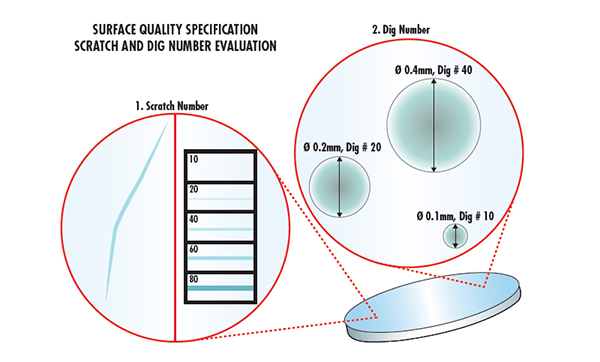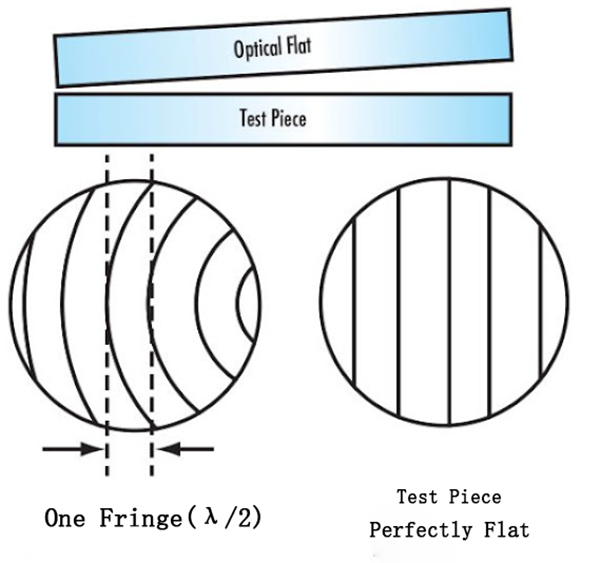Surface Specification
Surface Quality
The quality of an optical surface is used to measure the surface characteristics of an optical product and covers a number of imperfections such as scratches and pits. Most of these surface imperfections are purely cosmetic and do not greatly affect system performance, although, they may cause a small dip in system throughput and a finer scattering of scattered light. However, some surfaces will be more sensitive to these effects, such as: surfaces with image planes, where these imperfections can create focusing, and surfaces with high power levels, where these imperfections can increase energy absorption and ruin the optical product. The most commonly used specification for surface quality is the scratch and pitting specification illustrated by MIL-PRF-13830B. Scratch names are determined by comparing scratches on a surface to a series of standard scratches provided under controlled lighting conditions. Thus, rather than describing the actual scratches thereof, the scratch name compares them to standard scratches based on the MIL specifications. Pit names, however, relate directly to points or pits on a surface. Pit names are calculated by dividing the diameter of the pit in microns by 10. Typically a scratch pit specification between 80 and 50 would be considered standard quality, between 60 and 40 would be accurate quality, and between 20 and 10 would be considered high precision quality.
Surface flatness
p>Surface flatness is a type of specification that measures surface accuracy, and it is used to measure the deviation of flat surfaces such as mirrors, window pieces, prisms , or flat mirrors. You can measure this deviation using an optical flat crystal, which is a high-quality, high-precision reference plane used to compare the smoothness of specimens. When the plane of the optical product under test is placed against the optics, streaks appear, the shape of which indicates the surface smoothness of the optical product under test. If the streaks are equally spaced and are parallel straight lines, then the tested optical surface is at least as flat as the reference optical flat crystal. If the stripes are curved, the number of stripes between two dashed lines (one dashed line tangent to the midpoint of the stripe and the other dashed line passing through the endpoint of the same stripe) points to a smoothness error. Deviations in smoothness are usually measured in terms of ripple values (λ), which are composed of multiple wavelengths of the test source. One stripe corresponds to ½ of a wavelength. A smoothness of 1λ indicates an average quality level; a smoothness of λ/4 indicates an accurate quality level; and a smoothness of λ/20 indicates a high precision quality level.
Aperture number
Aperture number is a type of specification that measures the accuracy of a surface, which is applicable to curved optical surfaces or surfaces with power. The aperture number test is similar to a flatness test in that it compares the surface to a reference surface with a collegiate-accurate radius of curvature. Using the same interference principle generated by the gap between these two surfaces, the interference pattern of the stripes is used to characterize the deviation between the test surface and the reference surface. The deviation from the reference will produce a series of rings called Newton’s rings. The more rings present, the greater the deviation. The number of dark or bright rings, rather than the total number of both dark and bright rings, is equal to twice the wavelength error.
Irregularity
Irregularity is a type of specification that measures the accuracy of a surface and describes the deviation of the surface shape from a reference surface shape. Irregularity is measured in the same way as aperture number. Irregularity is the spherical circular streak formed by comparing the test surface to a reference surface. When the surface has an aperture number of more than 5 stripes, it will be difficult to detect small irregular shapes smaller than 1 stripe. Therefore, it is common practice to specify the ratio of the number of apertures to the irregularity of the surface so that it is approximately 5:1.
Surface Finish/surface roughness
Surface finish, also known as surface roughness, is used to measure small irregularities in a surface. They are usually the result of a poor polishing process. Rough surfaces tend to be more abrasion-resistant than smooth surfaces and may not be suitable for some applications, particularly those using lasers or in overheated environments, due to the possibility of minor breaks or imperfections at the nucleation site. Production tolerances for surface finishing are 50Å RMS for average quality, 20Å RMS for accurate quality, and 5Å RMS for high quality.
For more in-depth specification, please view our catalog optics or or feel free to contact us for more information.
Post time: Feb-28-2024







